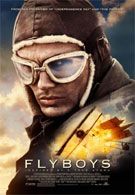World War I is long overdue for a proper trip across modern movie screens, but Flyboys isn't it. Director Tony Bill's film captures all the cliché's of every war movie ever made and rolls them into an experience punctuated by inconsistent performances and even more inconsistent storytelling. Snoopy's battles with the Red Baron felt more authentic than this.
The problems start with James Franco, who plays lead flyboy in the story of American airman flying for the French during World War I. It's based on a true story, which has kind of become the de facto excuse for making bad movies. Hey don't blame us! That's the way it is. Right. I'm not buying it. Franco plays a Texan with a southern accent that drifts in and out as if propelled by the wind. Sometimes he's a flying cowpoke, sometimes he's James Franco. Mostly, he's just bad at doing anything other than looking James Dean good.
Franco's squadron of biplane flying companions makes a motley crew of dissimilar comrades. There's the black guy who can't get a break in the U.S., the religious guy, the guy who's afraid to fight, the funny guy who can't shoot straight, and the snobby rich kid. They're bossed around by an oh-so-dark and dashing squadron commander and default French guy Jean Reno. Whatever happened to Gerard Depardieu?
Flyboys exists in a lazy, laid back version of The Great War that simply could not have existed. The pilots lounge around in picturesque France, taking their time to learn to fly and shoot while somewhere over that stand of trees somewhere a war happens. Sometimes they go out and sometimes they die, but our heroes always come back home to a nice cozy, safe bed. The reality of the first terrible world war never really touches the characters in this film and because of that we never get any tangible sense of what exactly it is that they're fighting for.
Let's face it though, if you're anything like me you're here for the dogfights. Prop plane dogfighting hasn't been done right since The Rocketeer and even there that wasn't exactly the point. Biplanes may not move quickly, but the way they leave pilots hanging out there in the open air presents a unique opportunity to electrify audiences with a more up close and personal sort of flying.
Flyboys' planes look pretty, their CGI frames glistening in the sunlight as they dip, dive, and burn through the sky, but that thrill of being shot at in an open cockpit is nowhere to be found. There's rarely any sense of speed as they move, and the pilots all react as if they're being filmed in front of a bluescreen, which of course they are. There's a lot of talk about how excited these daring dos are to be up in the air, but very little while they're up there to actually indicate it. Bill uses a lot of really great, sharp looking wide shots, but he never lingers on each shot long enough to give us a real grasp of how it might feel to be in one. Worse, someone made the bizarre decision to tag all the planes' machinegun fire with thick smoke trails. If I'd never seen a bullet fired in a movie before it might seem cool, but since I have and thus know they don't leave a contrail like a missile, it's distracting. Bullets don't spew smoke as they fly towards their targets. Choosing a special effect so outside reality in a film planted so firmly in reality is bizarre.
The movie never captures the thrill of dogfighting, however the planes do look sharp on screen and for aviation buffs seeing those old prop engines up there might be enough. For the rest of us, seeing Flyboys means fighting through a plodding, repetitive musical score and a lot of bad acting to get to an unsatisfying ending. Based on a true story or not, this is one adventure that might have been better left on the runway.
Most Popular





